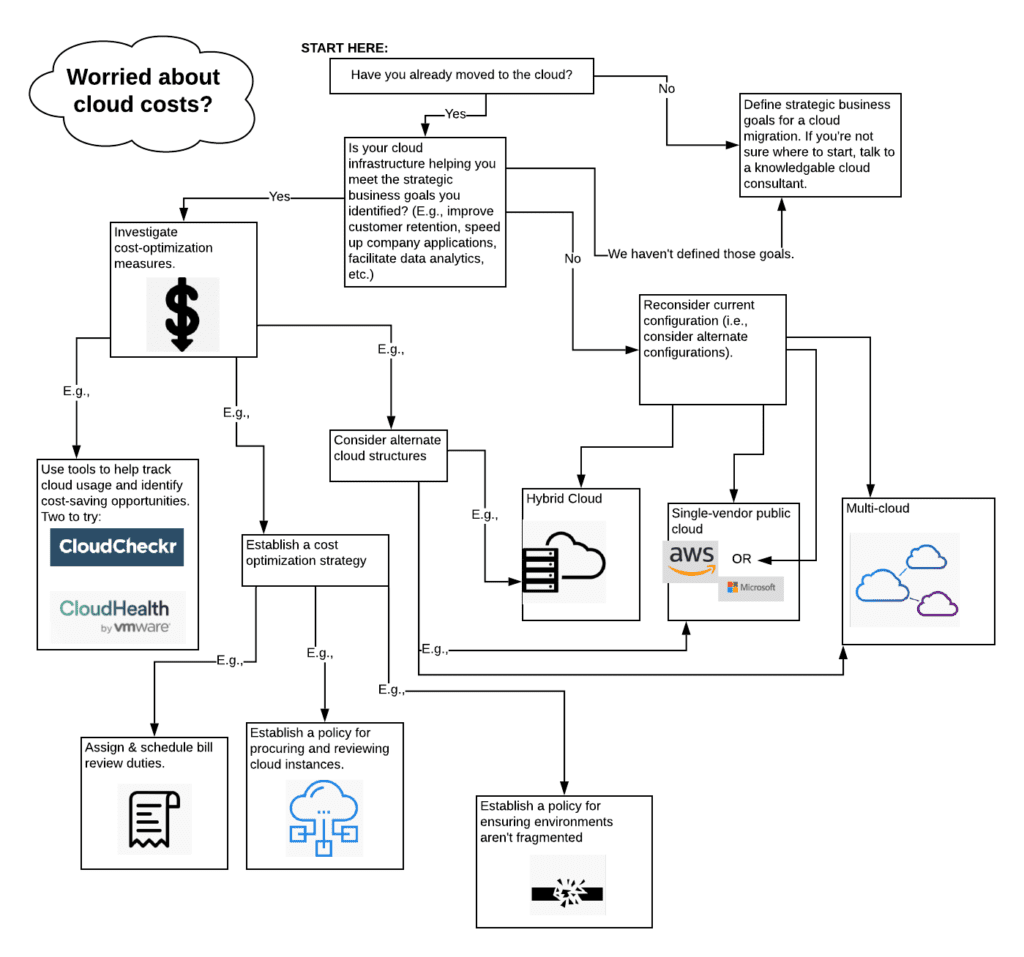
Remember the early days of moving to the cloud? It seemed like there was nothing the cloud couldn’t do — and for less money than dedicated servers.
A lot has changed in just a few years. In the early days of cloud adoption, it was normal for businesses to have about five percent of workflows in the cloud; today, that number is closer to 30 percent. That increase in cloud usage has come with a similar increase in cost. Unfortunately, the cost hikes weren’t part of the plan.
Gartner estimates that by 2020, 80 percent of organizations will have overshot their cloud budgets, largely because they lack optimization. A systemic failure to plan has led to cloud costs getting out of control.
The good news is that controlling cloud costs is well within the capabilities of most organizations. Here, I’ll outline a cloud cost control strategy that will work for the long term so that your organization can enjoy all the benefits of operating from the cloud without exceeding your budget. It starts with reviewing the strategy behind your organization’s decision to move to the cloud.

Start with strategic reasons for cloud adoption
Before an organization can try to get its cloud costs under control, it’s important to review the underlying business drivers that led to cloud adoption in the first place.
Think of it this way: if you realize you’re paying too much in rent, you can’t just move into a cheaper home to fix the problem. You have to first define what you need from that home: how many bedrooms, whether you need central air, whether you need a parking space, etc. If you have three kids and you cut costs by moving to a studio apartment, you haven’t really solved the problem.
The same is true for cloud infrastructure. Your organization has certain functionality, security, and operational needs. Whether you’re operating in the cloud or from in-house servers, you have to be able to meet those needs. Any cloud cost control efforts must work within those parameters.
So go back to the drawing board. Why did your organization decide to adopt cloud infrastructure in the first place? For example, maybe you wanted to…
- Improve security.
- Improve scalability or flexibility.
- Facilitate work among dispersed team members.
- Add a more robust disaster recovery plan.
- Reduce costs.
Or maybe word came down from leadership that you had to move to the cloud without a clear reason why. That happens, too. What’s important now is to determine which of the above objectives are most important to your organization.
Once you have a sense of that, ask a simple question: is the cloud helping you achieve those goals?
If your primary reason for moving to the cloud was to save money and your costs are now out of control, the answer is clear. But for most of the other reasons, you’ll probably have to do some digging. For example: if you wanted to facilitate work among geographically distant team members, the cloud has probably done that — but what’s the value to your business? How does that value compare to the cost of your cloud infrastructure? And so on.
If the cloud’s not helping you achieve your goals: adjust your cloud infrastructure
If your current cloud setup is not helping your business achieve the strategic goals it had for its cloud migration, your first order of business should be to adjust your cloud infrastructure. After all, there’s no point in saving money on your cloud bills if you’re paying for something that’s not moving your business in the direction it needs to go.
What kind of adjustments are we talking about?
That depends entirely on the specifics of your business.
One example we’ve seen: a company came to us because they were shocked by a cloud bill. We looked at their setup and saw that they had a lot of mostly static data stored in the cloud, meaning they were paying a lot of money for this data to sit around. We suggested they shift that data to an in-house server. It was that simple, and the solution helped them significantly lower their cloud bill.
The important thing to note here is that it involved rethinking their infrastructure setup holistically rather than simply looking for ways to reduce their cloud bills.
More often than not, a cloud cost problem is actually an infrastructure or architecture problem in disguise.
If you’re not sure where to start when evaluating cloud infrastructure options, let us help! As cloud consultants, this is our area of expertise. We spend all day every day understanding organizations’ business goals and identifying cloud (and non-cloud) technologies to help them get there.
If the cloud is helping you achieve your goals: look to strategy, architecture, and tools to reduce cost
So what happens when the cloud is providing the strategic benefits you’d hoped for but at a price point that’s way over budget?
At this point, we recommend examining these things:
- Your overall cloud strategy
- The architecture of your apps
- Tools to support cloud cost management
Notice “tools” is the last item on that list. That’s because, while you can get real value from the tools and software that can help you keep cloud costs under control, they won’t be effective without addressing the other two items on that list.
To return to the housing analogy, think of cloud cost management tools as smart home devices. They may help you optimize your utility use, but they won’t offer the kind of savings that getting into the right-size home in an affordable neighborhood will have.
Assessing your cloud strategy
In an ideal world, you’ll think about your cloud strategy — that is, your big-picture business plan for moving to the cloud — before you move a single instance. Setting out with a clear strategy in place is the single best way to ensure cloud cost optimization.
So if you’re still considering a move to the cloud, make time for strategy now. Seriously. Find a cloud consultant you trust, work with them to understand how the cloud can help you run your business better, and then move strategically move to the cloud. When you take that approach, you’ll find that your costs are automatically optimized.
If you’ve already moved some or all of your business to the cloud, don’t worry. If you need to pivot, pivot. There’s still time to develop a strategy — and doing so may be your best bet at controlling your cloud costs for the long term.
Reconsidering your apps’ architecture
Once you’re confident that your overall cloud strategy makes sense, it’s time to get into the nitty gritty of how individual apps are built.
To get an idea of how changing architecture can help manage cloud costs, consider these two common problems we see:
- Apps that were hosted in-house are “lifted and shifted” to the cloud without any changes. Just as you can’t move the exact furniture layout from one home to another, it’s usually inefficient to move an app from one environment to another without making adjustments — refactoring, replatforming, rehosting, etc. So restructuring your apps to suit the cloud could translate to using fewer resources to run the app and therefore paying less in cloud bills.
- In multi-cloud environments, apps straddling multiple clouds are making data requests inefficiently, such that the organization is effectively double-paying for cloud resources. Again, restructuring the way the app operates can improve cost efficiency without affecting performance or user experience.
Working with experienced cloud consultants to build your apps in a way that makes sense for your cloud environment can help you optimize the cloud resources you’re using, which can help keep cloud costs under control.
Using cost-control tools
When you’re confident that your big-picture strategy has you on a path toward long-term business success and your apps are built in such a way that they’re efficiently using your cloud resources, it’s time to add some cost-saving tools to the mix.
Software like CloudCheckr and CloudHealth monitor cloud bills and flag anything that might be causing problems, from excessive charges to security risks.
But keep in mind that these tools are valuable complements to the humans monitoring your cloud bills — not replacements. While they undoubtedly facilitate the process of reviewing a bill that might be thousands or even millions of lines long, they are not specific to your business (or to anyone’s business).
And remember (broken record alert): your cloud usage has to align with your larger business goals. That means you’ll need a person to evaluate the alerts these tools send and decide whether you need to take any action.
Your tool might send up a red flag, for example, to alert you that a database is exposed to the internet — when in reality that particular database is absolutely supposed to be. It’s crucial that someone be able to know when to take action to mitigate your risks and when to dismiss the notifications altogether — without that person, you could spend a lot of valuable time “fixing” things that aren’t broken.
Working with a cloud consultant to make cost control a reality
We’ve used housing as a metaphor to talk about cloud configurations throughout this piece because there are as many potential cloud configurations as there are housing options. Apartment vs. house vs. condo is just the start — you also have to consider the overall size of your building, how much land you’re on, your location in the world, and so on.
Once you’ve considered all these factors, the home you choose will depend on two major factors: your lifestyle and your budget.
The same is true for configuring cloud infrastructure for your company: it must work for your specific business needs and for the money you have available.
The good news: this means that there is almost certainly a cloud setup that will make your business more efficient, customer-friendly, and profitable.
The challenge: you probably won’t just happen into the right configuration without guidance from a knowledgeable cloud consultant.
If you’ve already moved some or all of your business to the cloud and it’s costing more than you expected, working with a cloud consultant will help you identify workable alternatives that let you control your costs.
If you’re eager to see how the cloud can improve your business but concerned about cloud costs spiralling out of control, working with a cloud consultant will make sure that you migrate in a way that helps you manage costs for the long term.
What to look for from a cloud consulting service
You’ll know you’ve found a consultant you can trust when they start your engagement by asking about your business. You wouldn’t want a real estate agent who doesn’t care about your desired school district, and you don’t want a cloud consultant who isn’t interested in learning exactly what your organization wants and needs to accomplish in the short, medium, and long term.
Interested in starting your cloud consultation right now? Get in touch.
